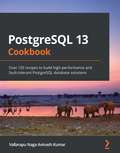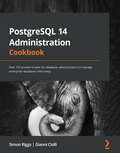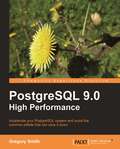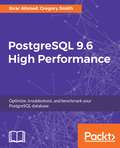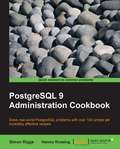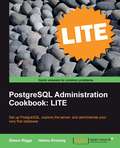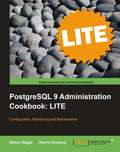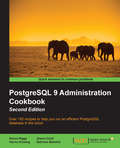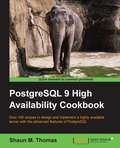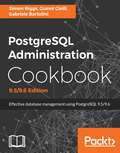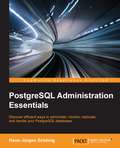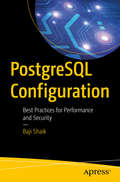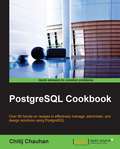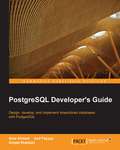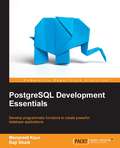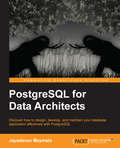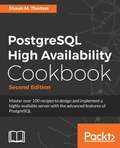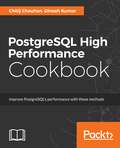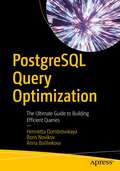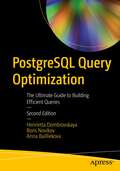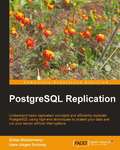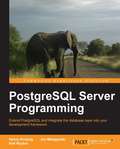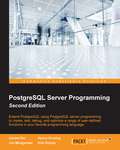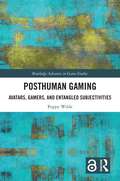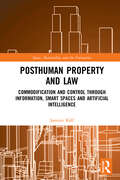- Table View
- List View
PostgreSQL 13 Cookbook: Over 120 recipes to build high-performance and fault-tolerant PostgreSQL database solutions
by Vallarapu Naga KumarGet to grips with building reliable, scalable, and maintainable database solutions for enterprises and production databasesKey FeaturesImplement PostgreSQL 13 features to perform end-to-end modern database managementDesign, manage, and build enterprise database solutions using a unique recipe-based approachSolve common and not-so-common challenges faced while working to achieve optimal database performanceBook DescriptionPostgreSQL has become the most advanced open source database on the market. This book follows a step-by-step approach, guiding you effectively in deploying PostgreSQL in production environments. The book starts with an introduction to PostgreSQL and its architecture. You'll cover common and not-so-common challenges faced while designing and managing the database. Next, the book focuses on backup and recovery strategies to ensure your database is steady and achieves optimal performance. Throughout the book, you'll address key challenges such as maintaining reliability, data integrity, a fault-tolerant environment, a robust feature set, extensibility, consistency, and authentication. Moving ahead, you'll learn how to manage a PostgreSQL cluster and explore replication features for high availability. Later chapters will assist you in building a secure PostgreSQL server, along with covering recipes for encrypting data in motion and data at rest. Finally, you'll not only discover how to tune your database for optimal performance but also understand ways to monitor and manage maintenance activities, before learning how to perform PostgreSQL upgrades during downtime. By the end of this book, you'll be well-versed with the essential PostgreSQL 13 features to build enterprise relational databases.What you will learnUnderstand logical and physical backups in PostgresDemonstrate the different types of replication methods possible with PostgreSQL todaySet up a high availability cluster that provides seamless automatic failover for applicationsSecure a PostgreSQL encryption through authentication, authorization, and auditingAnalyze the live and historic activity of a PostgreSQL serverUnderstand how to monitor critical services in Postgres 13Manage maintenance activities and performance tuning of a PostgreSQL clusterWho this book is forThis PostgreSQL book is for database architects, database developers and administrators, or anyone who wants to become well-versed with PostgreSQL 13 features to plan, manage, and design efficient database solutions. Prior experience with the PostgreSQL database and SQL language is expected.
PostgreSQL 14 Administration Cookbook: Over 175 proven recipes for database administrators to manage enterprise databases effectively
by Simon Riggs Gianni CiolliAdminister, monitor, and replicate your PostgreSQL 14 database for efficient database management and maintenanceKey FeaturesTroubleshoot and tackle any administration and management problems in PostgreSQL 14Find expert techniques for monitoring, fine-tuning, and securing your databaseAdopt efficient replication for high availability with PostgreSQL 14Book DescriptionPostgreSQL is a powerful, open-source database management system with an enviable reputation for high performance and stability. With many new features in its arsenal, PostgreSQL 14 allows you to scale up your PostgreSQL infrastructure. With this book, you'll take a step-by-step, recipe-based approach to effective PostgreSQL administration.This book will get you up and running with all the latest features of PostgreSQL 14 while helping you explore the entire database ecosystem. You'll learn how to tackle a variety of problems and pain points you may face as a database administrator such as creating tables, managing views, improving performance, and securing your database. As you make progress, the book will draw attention to important topics such as monitoring roles, validating backups, regular maintenance, and recovery of your PostgreSQL 14 database. This will help you understand roles, ensuring high availability, concurrency, and replication. Along with updated recipes, this book touches upon important areas like using generated columns, TOAST compression, PostgreSQL on the cloud, and much more.By the end of this PostgreSQL book, you'll have gained the knowledge you need to manage your PostgreSQL 14 database efficiently, both in the cloud and on-premise.What you will learnPlan, manage, and maintain PostgreSQL databases in productionWork with the newly introduced features of PostgreSQL 14Use pgAdmin or OmniDB to perform database administrator (DBA) tasksUse psql to write accurate and repeatable scriptsUnderstand how to tackle real-world data issues with the help of examplesSelect and implement robust backup and recovery techniques in PostgreSQL 14Deploy best practices for planning and designing live databasesWho this book is forThis Postgres 14 book is for database administrators, data architects, database developers, and anyone with an interest in planning and running live production databases using PostgreSQL 14. Those looking for hands-on solutions to any problem associated with PostgreSQL 14 administration will also find this book useful. Some experience with handling PostgreSQL databases will help you to make the most out of this book, however, it is a useful resource even if you are just beginning your Postgres journey.
PostgreSQL 9.0 High Performance
by Gregory SmithImproving database performance requires an equal mix of understanding theoretical concepts and working through hands-on examples. You'll find both here. Many of the examples given will be immediately useful for monitoring and improving your PostgreSQL deployments, providing insight into hard-to-obtain information about your database. This book is aimed at intermediate to advanced database administrators using or planning to use PostgreSQL. Portions will also interest systems administrators looking to build or monitor a PostgreSQL installation, as well as developers interested in advanced database internals that impact application design.
PostgreSQL 9.6 High Performance
by Gregory Smith Ibrar AhmedEnhance the performance of your PostgreSQL system with this handy guide while avoiding common pitfalls that can slow it down. About This Book • Learn the right techniques to obtain optimal PostgreSQL database performance, ranging from initial design to routine maintenance • Fine tune the performance of your queries and avoid the common pitfalls that can slow your system down • Contains tips and tricks on scaling successful database installations, and ensuring a highly available PostgreSQL solution Who This Book Is For This book is for intermediate to advanced database administrators and developers who use or plan to exploit the features of PostgreSQL in the best possible manner. While administrators can benefit from the topics related to the installation, configuration, and optimization of the server, developers will learn how to write optimal queries and address performance issues in their database design. This book will also benefit the PostgreSQL internal architects in being able to monitor the performance using benchmarking tools. What You Will Learn • Learn the best practices to configure your PostgreSQL 9.6 database for optimal performance • Write optimal queries and techniques to detect performance issue in queries • Fine tune the performance of your queries using benchmarking and indexing techniques • Ensure high performance and a highly available database using the scaling and replication techniques • Discover how to make informed speed and reliability trade-offs • Handle increasing database workloads without any hassle • Use monitoring insights to continuously rework the design and configuration for best performance In Detail Database administrators and developers spend years learning techniques to configure their PostgreSQL database servers for optimal performance, mostly when they encounter performance issues. Scalability and high availability of the database solution is equally important these days. This book will show you how to configure new database installations and optimize existing database server installations using PostgreSQL 9.6. You will start with the basic concepts of database performance, because all successful database applications are destined to eventually run into issues when scaling up their performance. You will not only learn to optimize your database and queries for optimal performance, but also detect the real performance bottlenecks using PostgreSQL tools and some external tools. Next, you will learn how to benchmark your hardware and tune your operating system. Optimize your queries against the database with the help of right indexes, and monitor every layer, ranging from hardware to queries. Moving on, you will see how connection pooling, caching, partitioning, and replication will help you handle increasing database workloads. Achieving high database performance is not easy, but you can learn it by using the right guide—PostgreSQL 9.6 High Performance. Style and approach This book has been organized in such a manner that will help you understand basic PostgreSQL 9.6 performance tuning to advanced-level configuration. There are many real-world problems explained in this book and explained in clear language, because improving database performance requires an equal mix of understanding theoretical concepts and working through hands-on examples.
PostgreSQL 9 Admin Cookbook
by Hannu Krosing Simon RiggsWritten in the cookbook style, this book offers learning and techniques through recipes. It contains step-by-step instructions for administrators and developers to manage databases on PostgreSQL. The book is designed in such a way that you can read it chapter by chapter or refer to recipes in no particular order.This book is for Sysadmins, Database Administrators, Architects, Developers, and anyone with an interest in planning for or running live production databases. This book is most suited to those who have some technical experience.
PostgreSQL 9 Administration Cookbook: LITE Edition
by Simon RiggsWritten in the cookbook style, this book offers learning and techniques through recipes. It contains step-by-step instructions for administrators and developers to manage databases in PostgreSQL. The book is designed in such a way that you can read it chapter by chapter or refer to recipes in no particular order. This book is for Sysadmins, Database Administrators, Architects, Developers, and anyone with an interest in planning for or running live production databases.
PostgreSQL 9 Administration Cookbook LITE: Configuration, Monitoring and Maintenance
by Simon Riggs Hannu KrosingWritten in the cookbook style, this book offers learning and techniques through recipes. It contains step-by-step instructions for administrators and developers to manage databases in PostgreSQL. The book is designed in such a way that you can read it chapter by chapter or refer to recipes in no particular order. This book is for Sysadmins, Database Administrators, Architects, Developers, and anyone with an interest in planning for or running live production databases. The book assumes that you are familiar with the basic operation of PostgreSQL.
PostgreSQL 9 Administration Cookbook - Second Edition
by Gianni Ciolli Simon RiggsThrough example-driven recipes, with plenty of code, focused on the most vital features of the latest PostgreSQL version (9.4), both administrators and developers will follow short, specific guides to understand and leverage useful Postgre functionalities to create better and more efficient databases.
PostgreSQL 9 High Availability Cookbook
by Shaun M. ThomasA comprehensive series of dependable recipes to design, build, and implement a PostgreSQL server architecture free of common pitfalls that can operate for years to come. Each chapter is packed with instructions and examples to simplify even highly complex database operations. If you are a PostgreSQL DBA working on Linux systems who want a database that never gives up, this book is for you. If you've ever experienced a database outage, restored from a backup, spent hours trying to repair a malfunctioning cluster, or simply want to guarantee system stability, this book is definitely for you.
PostgreSQL Administration Cookbook - Third Edition
by Simon Riggs Gianni CiolliIf you are an administrator who wants to leverage the useful PostgreSQL functionalities to create and manage databases efficiently, this is the book for you. This book assumes a basic working knowledge of PostgreSQL, and some previous experience in PostgreSQL administration is required.
PostgreSQL Administration Essentials
by Hans-Jurgen SchonigIf you are a database administrator who needs to get to grips with PostgreSQL quickly and efficiently, then this book is for you. This book will also be highly beneficial if you are a project leader or a developer who is interested in knowing more about database systems or bottleneck detection, as it will enable you to work more closely and cooperatively with your administrators.
PostgreSQL Configuration: Best Practices for Performance and Security
by Baji ShaikObtain all the skills you need to configure and manage a PostgreSQL database. In this book you will begin by installing and configuring PostgreSQL on a server by focusing on system-level parameter settings before installation. You will also look at key post-installation steps to avoid issues in the future. The basic configuration of PostgreSQL is tuned for compatibility rather than performance. Keeping this in mind, you will fine-tune your PostgreSQL parameters based on your environment and application behavior. You will then get tips to improve database monitoring and maintenance followed by database security for handling sensitive data in PostgreSQL. Every system containing valuable data needs to be backed-up regularly. PostgreSQL follows a simple back-up procedure and provides fundamental approaches to back up your data. You will go through these approaches and choose the right one based on your environment. Running your application with limited resources can be tricky. To achieve this you will implement a pooling mechanism for your PostgreSQL instances to connect to other databases. Finally, you will take a look at some basic errors faced while working with PostgreSQL and learn to resolve them in the quickest manner. What You Will Learn Configure PostgreSQL for performance Monitor and maintain PostgreSQL instances Implement a backup strategy for your data Resolve errors faced while using PostgreSQL Who This Book Is ForReaders with basic knowledge of PostgreSQL who wish to implement key solutions based on their environment.
PostgreSQL Cookbook
by Chitij ChauhanIf you are a system administrator, database administrator, architect, developer, or anyone with an interest in planning, managing, and designing database solutions using PostgreSQL, this is the book for you. This book is suited for you if you have some prior experience with any relational database or with the SQL language.
PostgreSQL Developer's Guide
by Ibrar Ahmed Asif FayyazIf you are a database developer who wants to learn how to design and implement databases for application development using PostgreSQL, this is the book for you. Existing knowledge of basic database concepts and some programming experience is required
PostgreSQL Development Essentials
by Baji Shaik Manpreet KaurDevelop programmatic functions to create powerful database applications About This Book * Write complex SQL queries and design a robust database design that fits your application's need * Improve database performance by indexing, partitioning tables, and query optimizing * A comprehensive guide covering the advanced PostgreSQL concepts without any hassle Who This Book Is For If you are a PostgreSQL developer with a basic knowledge of PostgreSQL development and you're want deeper knowledge to develop applications, then this book is for you. As this book does not cover basic installation and configurations, you should have PostgreSQL installed on your machine as a prerequisite. What You Will Learn * Write more complex queries with advanced SQL queries * Design a database that works with the application exactly the way you want * Make the database work in extreme conditions by tuning, optimizing, partitioning, and indexing * Develop applications in other programming languages such as Java and PHP * Use extensions to get extra benefits in terms of functionality and performance * Build an application that does not get locked by data manipulation * Explore in-built db functions and data type conversions In Detail PostgreSQL is the most advanced open source database in the world. It is easy to install, configure, and maintain by following the documentation; however, it's difficult to develop applications using programming languages and design databases accordingly. This book is what you need to get the most out of PostgreSQL You will begin with advanced SQL topics such as views, materialized views, and cursors, and learn about performing data type conversions. You will then perform trigger operations and use trigger functions in PostgreSQL. Next we walk through data modeling, normalization concepts, and the effect of transactions and locking on the database. The next half of the book covers the types of indexes, constrains, and the concepts of table partitioning, as well as the different mechanisms and approaches available to write efficient queries or code. Later, we explore PostgreSQL Extensions and Large Object Support in PostgreSQL. Finally, you will perform database operations in PostgreSQL using PHP and Java. By the end of this book, you will have mastered all the aspects of PostgreSQL development. You will be able to build efficient enterprise-grade applications with PostgreSQL by making use of these concepts Style and approach Every chapter follows a step by step approach that first explains the concept , then shows you how to execute it practically so that you can implement them in your application.
PostgreSQL for Data Architects
by Jayadevan MaymalaThis book is for developers and data architects who have some exposure to databases. It is assumed that you understand the basic concepts of tables and common database objects, including privileges and security.
PostgreSQL High Availability Cookbook - Second Edition
by Shaun M. ThomasMaster over 100 recipes to design and implement a highly available server with the advanced features of PostgreSQL About This Book • Create a PostgreSQL cluster that stays online even when disaster strikes • Avoid costly downtime and data loss that can ruin your business • Updated to include the newest features introduced in PostgreSQL 9.6 with hands-on industry-driven recipes Who This Book Is For If you are a PostgreSQL DBA working on Linux systems who want a database that never gives up, this book is for you. If you've ever experienced a database outage, restored from a backup, spent hours trying to repair a malfunctioning cluster, or simply want to guarantee system stability, this book is definitely for you. What You Will Learn • Protect your data with PostgreSQL replication and management tools such as Slony, Bucardo, pglogical, and WAL-E • Hardware planning to help your database run efficiently • Prepare for catastrophes and prevent them before they happen • Reduce database resource contention with connection pooling using pgpool and PgBouncer • Automate monitoring and alerts to visualize cluster activity using Nagios and collected • Construct a robust software stack that can detect and fix outages • Learn simple PostgreSQL High Availability with Patroni, or dive into the full power of Pacemaker. In Detail Databases are nothing without the data they store. In the event of a failure - catastrophic or otherwise - immediate recovery is essential. By carefully combining multiple servers, it's even possible to hide the fact a failure occurred at all. From hardware selection to software stacks and horizontal scalability, this book will help you build a versatile PostgreSQL cluster that will survive crashes, resist data corruption, and grow smoothly with customer demand. It all begins with hardware selection for the skeleton of an efficient PostgreSQL database cluster. Then it's on to preventing downtime as well as troubleshooting some real life problems that administrators commonly face. Next, we add database monitoring to the stack, using collectd, Nagios, and Graphite. And no stack is complete without replication using multiple internal and external tools, including the newly released pglogical extension. Pacemaker or Raft consensus tools are the final piece to grant the cluster the ability to heal itself. We even round off by tackling the complex problem of data scalability. This book exploits many new features introduced in PostgreSQL 9.6 to make the database more efficient and adaptive, and most importantly, keep it running. Style and approach This book contains practical recipes that will help the reader solve real world problems related to high availability in PostgreSQL. Every recipe is explained in detail, with relevant explanations, tips and tricks provided for quicker and easier understanding.
PostgreSQL High Performance Cookbook
by Dinesh Kumar Chitij ChauhanGet to know effective ways to improve PostgreSQL's performance and master query optimization, and database monitoring. About This Book • Perform essential database tasks such as benchmarking the database and optimizing the server's memory usage • Learn ways to improve query performance and optimize the PostgreSQL server • Explore a wide range of high availability and replication mechanisms to build robust, highly available, scalable, and fault-tolerant PostgreSQL databases Who This Book Is For If you are a developer or administrator with limited PostgreSQL knowledge and want to develop your skills with this great open source database, then this book is ideal for you. Learning how to enhance the database performance is always an exciting topic to everyone, and this book will show you enough ways to enhance the database performance. What You Will Learn • Build replication strategies for homogeneous and heterogeneous databases • Test and build a powerful machine with multiple bench marking techniques • Get to know a few SQL injection techniques • Find out how to manage the replication using multiple tools • Benchmark the database server using multiple strategies • Work with the query processing algorithms and their internal behaviors • Build a proper plan to upgrade or migrate to PostgreSQL from other databases • See the essential database load balancing techniques and the various partitioning approaches PostgreSQL provides • Learn memory optimization techniques and database server configurations In Detail PostgreSQL is one of the most powerful and easy to use database management systems. It has strong support from the community and is being actively developed with a new release every year. PostgreSQL supports the most advanced features included in SQL standards. It also provides NoSQL capabilities and very rich data types and extensions. All of this makes PostgreSQL a very attractive solution in software systems. If you run a database, you want it to perform well and you want to be able to secure it. As the world's most advanced open source database, PostgreSQL has unique built-in ways to achieve these goals. This book will show you a multitude of ways to enhance your database's performance and give you insights into measuring and optimizing a PostgreSQL database to achieve better performance. This book is your one-stop guide to elevate your PostgreSQL knowledge to the next level. First, you'll get familiarized with essential developer/administrator concepts such as load balancing, connection pooling, and distributing connections to multiple nodes. Next, you will explore memory optimization techniques before exploring the security controls offered by PostgreSQL. Then, you will move on to the essential database/server monitoring and replication strategies with PostgreSQL. Finally, you will learn about query processing algorithms. Style and approach This comprehensive guide is packed with practical administration tasks. Each topic is explained using examples and a step-by-step approach.
PostgreSQL Query Optimization: The Ultimate Guide to Building Efficient Queries
by Henrietta Dombrovskaya Boris Novikov Anna BailliekovaWrite optimized queries. This book helps you write queries that perform fast and deliver results on time. You will learn that query optimization is not a dark art practiced by a small, secretive cabal of sorcerers. Any motivated professional can learn to write efficient queries from the get-go and capably optimize existing queries. You will learn to look at the process of writing a query from the database engine’s point of view, and know how to think like the database optimizer. The book begins with a discussion of what a performant system is and progresses to measuring performance and setting performance goals. It introduces different classes of queries and optimization techniques suitable to each, such as the use of indexes and specific join algorithms. You will learn to read and understand query execution plans along with techniques for influencing those plans for better performance. The book also covers advanced topics such as the use of functions and procedures, dynamic SQL, and generated queries. All of these techniques are then used together to produce performant applications, avoiding the pitfalls of object-relational mappers. What You Will LearnIdentify optimization goals in OLTP and OLAP systemsRead and understand PostgreSQL execution plansDistinguish between short queries and long queriesChoose the right optimization technique for each query typeIdentify indexes that will improve query performanceOptimize full table scansAvoid the pitfalls of object-relational mapping systemsOptimize the entire application rather than just database queries Who This Book Is ForIT professionals working in PostgreSQL who want to develop performant and scalable applications, anyone whose job title contains the words “database developer” or “database administrator" or who is a backend developer charged with programming database calls, and system architects involved in the overall design of application systems running against a PostgreSQL database
PostgreSQL Query Optimization: The Ultimate Guide to Building Efficient Queries
by Henrietta Dombrovskaya Boris Novikov Anna BailliekovaWrite optimized queries. This book helps you write queries that perform fast and deliver results on time. You will learn that query optimization is not a dark art practiced by a small, secretive cabal of sorcerers. Any motivated professional can learn to write efficient queries from the get-go and capably optimize existing queries. You will learn to look at the process of writing a query from the database engine’s point of view, and know how to think like the database optimizer. The book begins with a discussion of what a performant system is and progresses to measuring performance and setting performance goals. It introduces different classes of queries and optimization techniques suitable to each, such as the use of indexes and specific join algorithms. You will learn to read and understand query execution plans along with techniques for influencing those plans for better performance. The book also covers advanced topics such as the use of functions and procedures, dynamic SQL, and generated queries. All of these techniques are then used together to produce performant applications, avoiding the pitfalls of object-relational mappers.This second edition includes new examples using Postgres 15 and the newest version of the PostgresAir database. It includes additional details and clarifications about advanced topics, and covers configuration parameters in greater depth. Finally, it makes use of advancements in NORM, using automatically generated functions. What You Will LearnIdentify optimization goals in OLTP and OLAP systemsRead and understand PostgreSQL execution plansDistinguish between short queries and long queriesChoose the right optimization technique for each query typeIdentify indexes that will improve query performanceOptimize full table scansAvoid the pitfalls of object-relational mapping systemsOptimize the entire application rather than just database queries Who This Book Is ForIT professionals working in PostgreSQL who want to develop performant and scalable applications, anyone whose job title contains the words “database developer” or “database administrator" or who is a backend developer charged with programming database calls, and system architects involved in the overall design of application systems running against a PostgreSQL database
PostgreSQL Replication
by Zoltan Boszormenyi Hans-Jurgen SchonigThis book has a chapter dedicated to each aspect of replication. The new features of PostgreSQL 9 are introduced and there are lots of practical examples and screenshots."PostgreSQL Replication" is ideal for PostgreSQL administrators who want to set up and understand replication. If you want to make your databases more robust, more secure, faster, and more scalable, you will find all the information you need in this single book focusing exclusively on PostgreSQL replication. It is assumed that you already have some basic experience with PostgreSQL.
PostgreSQL Server Programming
by Jim Mlodgenski Hannu Krosing Kirk RoybalThis practical guide leads you through numerous aspects of working with PostgreSQL. Step by step examples allow you to easily set up and extend PostgreSQL. "PostgreSQL Server Programming" is for moderate to advanced PostgreSQL database professionals. To get the best understanding of this book, you should have general experience in writing SQL, a basic idea of query tuning, and some coding experience in a language of your choice.
PostgreSQL Server Programming - Second Edition
by Hannu Krosing Usama DarThis book is for moderate to advanced PostgreSQL database professionals who wish to extend PostgreSQL, utilizing the most updated features of PostgreSQL 9.4. For a better understanding of this book, familiarity with writing SQL, a basic idea of query tuning, and some coding experience in your preferred language is expected.
Posthuman Gaming: Avatars, Gamers, and Entangled Subjectivities (Routledge Advances in Game Studies)
by Poppy WildePosthuman Gaming: Avatars, Gamers, and Entangled Subjectivities explores the relationship between avatar and gamer in the massively multiplayer online roleplaying game World of Warcraft, to examine notions of entangled subjectivity, affects and embodiments – what it means and how it feels to be posthuman. With a focus on posthuman subjectivity, Wilde considers how we can begin to articulate ourselves when the boundary between self and other is unclear. Drawing on fieldnotes of her own gameplay experiences, the author analyses how subjectivity is formed in ways that defy a single individual notion of "self", and explores how different practices, feelings, and societal understandings can disrupt strict binaries and emphasise our posthumanism. She interrogates if one can speak of an "I" in the face of posthuman multiplicity, before exploring different analytical themes, beginning with how acting theories might be posthumanised and articulate the relationship between avatar and gamer. She then defines posthuman empathy and explains how this is experienced in gaming, before addressing the need to account for boredom, the complexity of nostalgia, and ways death and loss are experienced through gaming. This volume will appeal to a broad audience and is particularly relevant to scholars and students of cultural studies, media studies, humanities, and game studies. Chapters 2 and 7 of this book are freely available as a downloadable Open Access PDF at http://www.taylorfrancis.com under a Creative Commons Attribution-Non Commercial-No Derivatives (CC-BY-NC-ND) 4.0 license.
Posthuman Property and Law: Commodification and Control through Information, Smart Spaces and Artificial Intelligence
by Jannice KällThis book analyses the phenomenon of digitally mediated property and considers how it problematises the boundary between human and nonhuman actors. The book addresses the increasingly porous border between personhood and property in digitized settings and considers how the increased commodification of knowledge makes visible a rupture in the liberal concept of the property owning, free, person. Engaging with the latest work in posthumanist and new materialist theory, it shows, how property as a concept as well as a means for control, changes fundamentally under advanced capitalism. Such change is exemplified by the way in which data, as an object of commodification, is extracted from human activities yet is also directly used to affectively control – or nudge – humans. Taking up a range of human engagements with digital platforms and coded architectures, as well as the circulation of affects through practices of artificial intelligence that are employed to shape behaviour, the book argues that property now needs to be understood according to an ecology of human as well as nonhuman actors. The idea of posthuman property, then, offers both a means to critique property control through digital technologies, as well as to move beyond the notion of the self-owning, object-owning, human. Engaging the most challenging contemporary technological developments, this book will appeal to researchers in the areas of Law and Technology, Legal Theory, Intellectual Property Law, Legal Philosophy, Sociology of Law, Sociology, and Media Studies.
